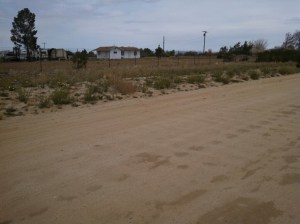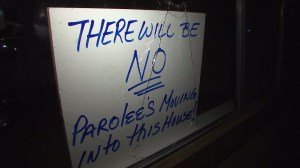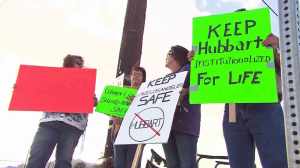Demonstrators were camped out in Lake Los Angeles on Friday night to protest the imminent release of the so-called “Pillowcase Rapist” to a home east of Palmdale following a Northern California judge’s ruling.

Earlier in the day, the judge announced that Christopher Evans Hubbart, 63, will be moved from a state mental hospital to a ramshackle home on a dirt road in an unincorporated area of Antelope Valley within 45 days — by July 7 — under a court order.
Hubbart admitted to raping dozens of women in Southern California and has been in and out of state custody since 1972 after repeatedly reoffending.
He will be required to wear a GPS ankle monitor and must attend therapy sessions twice per week. His home will be in the 20300 block of East Avenue R, about 20 miles east of central Palmdale (map).
A state contractor who supervises sexually violent predators will be assigned to Hubbart. For the first six months after his release, the supervisor will be with Hubbart every time the felon is in public, according to the Los Angeles County District Attorney’s Office, which announced the judge’s decision.

The location of Hubbart’s release was the subject of a court hearing Wednesday in San Jose, where Santa Clara County Superior Court Judge Gilbert Brown last year approved Hubbart’s request to be set free.
Brown had found that the convict’s “domicile” was Los Angeles County and decided that Hubbart should be release there.
In fall, after Brown tentatively approved Hubbart’s release to a home in Lake Los Angeles, about 7 miles from the Avenue R address to which he’ll be sent, a landlord withdrew the property from consideration.
Area residents had protested the release, and on Friday they gathered to voice their anger about the judge’s order.
“It angers me. It angers me because now all these women and these children are going to be in fear,” said Henrietta Andriese. “We’re not even safe anymore.”
Residents planned to camp out in front of the home overnight in an expression of their outrage.
Known as the “Pillowcase Rapist,” Hubbart had admitted to raping about 40 women between 1971 and 1982, according to the Los Angeles County DA’s office.

In the greater Los Angeles area, he admitted to targeted women whose garage doors were open, indicating their husbands had left for work. He would look for children’s toys, believing that mothers would be more likely to cooperate with him out of concern for their children, court records show.
Having grown up in Pasadena and Claremont, Hubbart was arrested in 1972 for crimes in Southern California, then released in 1979 to the San Francisco Bay Area, where he again sexually assaulted a series of women. He was sentenced in 1982 to 16 years in state prison, but was released in 1990.
He again reoffended and has been in state custody since 1996, most recently being housed at Coalinga State Hospital.
He was labeled a “sexually violent predator” under state law, a determination he unsuccessfully appealed.
Brown has jurisdiction over Hubbart’s release because the felon’s most recent crimes were in Santa Clara County.
In addition to Antelope Valley residents, local prosecutors and lawmakers have vocally opposed the release of Hubbart to Los Angeles County.

State Assemblyman Steve Fox, a Democrat who represents the Palmdale area, attended the Wednesday court hearing and stated that the lack of paved roads, street lighting and minimal policing made the area unsuitable for the release of a violent predator.
“Mr. Hubbart would present a clear and present danger to his neighbors, and would be an instant target for vigilantes,” Fox said in a statement.
Los Angeles County Sheriff John Scott, whose department will be responsible for policing Hubbart, was among the thousands who wrote letters and emails to Brown regarding the release.
Scott detailed Hubbart’s crimes, saying that the felon had raped a woman the very day he was paroled in 1983.
“Very few American criminals create the public fear Christopher Hubbart generates,” Scott wrote. “He is the most prolific and violent rapist I have encountered in 45 years of California law enforcement.”

Scott referred to the recent deaths of four Orange County women, allegedly at the hands of convicted sex offenders wearing GPS ankle monitors, as evidence that monitoring does not work.
Brown said he examined all the public comments he received.
“This court has reviewed them all,” Brown wrote in his single-page order for placement. “The court approves the proposed address. Mr. Hubbart is ordered to be placed within 45 days.”
L.A. County District Attorney Jackie Lacey said she was “extremely disappointed” by the court’s decision, saying the process had been “frustrating.”
The DA’s office had said that local prosecutors were not initially notified of a hearing about Hubbart’s petition for release.
Legislation proposed by Fox would require notification to communities in advance of the proposed release of sexually violent predators if such convicts were to be released to counties other than the one in which they were sentenced.
That legislation — Assembly Bill 1607 — passed the state Assembly unanimously on Friday, Lacey said.
“We must change the way these cases go through the court system,” Lacey said in a written statement. “We are hopeful that these changes will enable us to better protect the public in these cases.”














